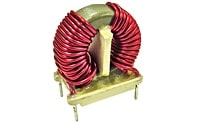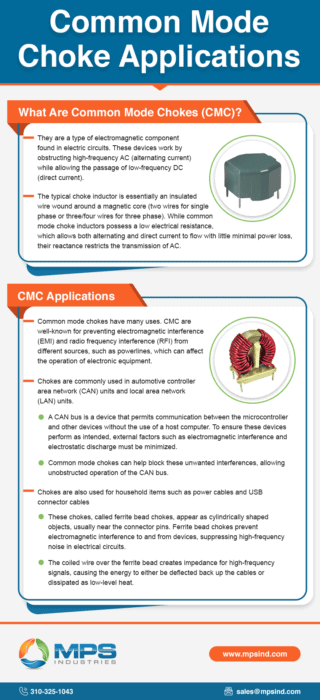Common Mode Chokes
What Are Common Mode Chokes (CMC)?

They are a type of electromagnetic component found in electric circuits. These devices work by obstructing high-frequency AC (alternating current) while allowing the passage of low-frequency DC (direct current). Choke inductors are named due to their ability to block (or choke) signals of specific frequencies. The typical choke inductor is essentially an insulated wire wound around a magnetic core (two wires for single phase or three/four wires for three phase). While common mode choke inductors possess a low electrical resistance, which allows both alternating and direct current to flow with little minimal power loss, their reactance restricts the transmission of AC.
These inductors are primarily used to prevent potentially damaging electromagnetic interference (EMI) and radio frequency interference (RFI) in various electronic and electrical devices and components.
Categories of Common Mode Chokes
These inductors are available in many forms, most of which are categorized by size, inductance, impedance, IDC, and DCR. However, almost all chokes are classified into two main categories based on FCC EMI/RFI requirements: audio frequency chokes (AFC) and radio frequency chokes (RFC).
Audio frequency chokes block high audio frequencies (typically greater than 30KHz) while letting DC pass. AFCs typically consist of ferromagnetic cores, which increase their inductance. Their construction is similar to transformers; they are comprised of iron cores with an air gap.
Radiofrequency chokes block radio frequencies and allow the free passage of audio and DC. They usually consist of ferrite cores or iron powder, which enhances inductance and improves the operational efficiency at a higher bandwidth. Radiofrequency chokes are typically wound in patterns, such as basket winding, to minimize secondary effects including self-capacitance and proximity effect losses.
Recently, common mode chokes have nano crystalline cores installed. This is a newer and popular option with a high permeability—about eight to ten times higher than ferrite core versions in the same dimension. They are designed for single or three phase applications. Their features include a compact smaller size, a frequency range up to 300Hz, and an increased EMI noise suppression performance.
CMC Applications

Chokes are commonly used in automotive controller area network (CAN) units and local area network (LAN) units. A CAN bus is a device that permits communication between the microcontroller and other devices without the use of a host computer. To ensure these devices perform as intended, external factors such as electromagnetic interference and electrostatic discharge must be minimized. Common mode chokes can help block these unwanted interferences, allowing unobstructed operation of the CAN bus.
Chokes are also used for household items such as power cables and USB connector cables. These chokes, called ferrite bead chokes, appear as cylindrically shaped objects, usually near the connector pins. Ferrite bead chokes prevent electromagnetic interference to and from devices, suppressing high-frequency noise in electrical circuits. The coiled wire over the ferrite bead creates impedance for high-frequency signals, causing the energy to either be deflected back up the cables or dissipated as low-level heat.
Differential vs. Common Mode Chokes
While they have similar attributes, common mode chokes are unique from differential mode chokes. The former blocks common mode signals or noise that flow in the same direction, while the latter blocks signals or noise that move in opposite directions. Common mode chokes appear in many electronic, telecommunications, and industrial applications. They suppress or remove noise on signal lines and power supply cables as well as filter the output, mitigating the noise that would go back on the power line. Differential mode chokes lessen high frequency AC currents in circuits with low DC or AC currents. They are used alone or grouped together and spaced across multiple locations. These chokes are common in the power return line and power out line of power supplies.
Custom Common Mode Chokes for Your Application

To learn more about chokes or our other products and services, contact us or request a quote.
Additional Resources for Common Mode Chokes
Explore some of our additional resources on common mode chokes below.
- Common Mode Choke Products
- Blog: How Do Common Choke Modes Work?
- Contact Us for more information about our common mode choke products.






